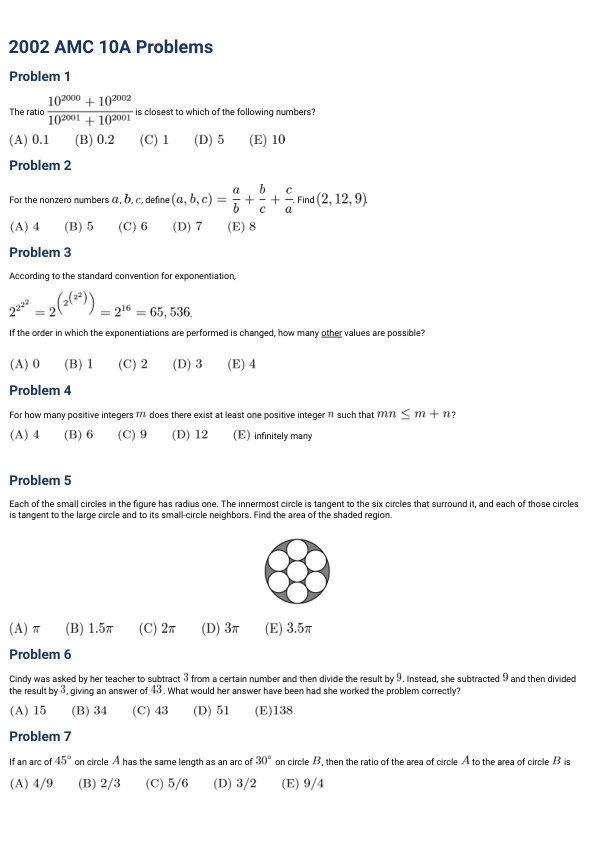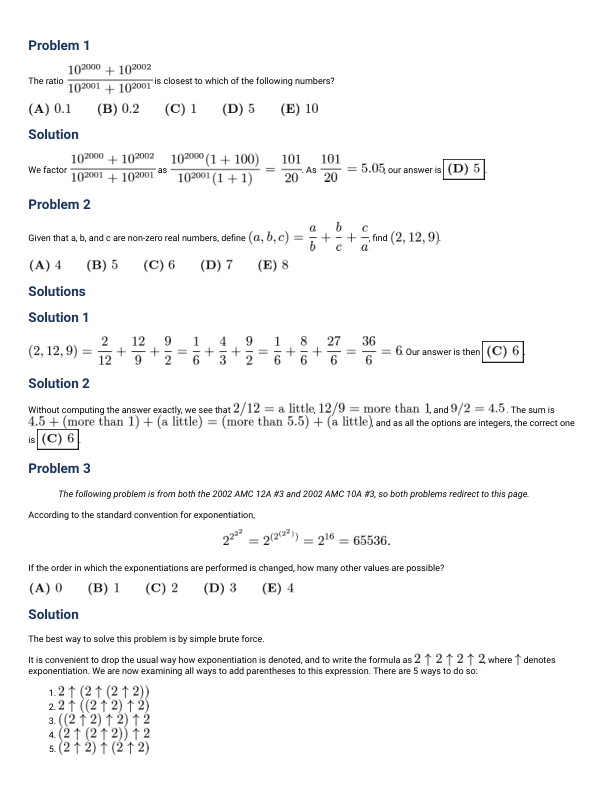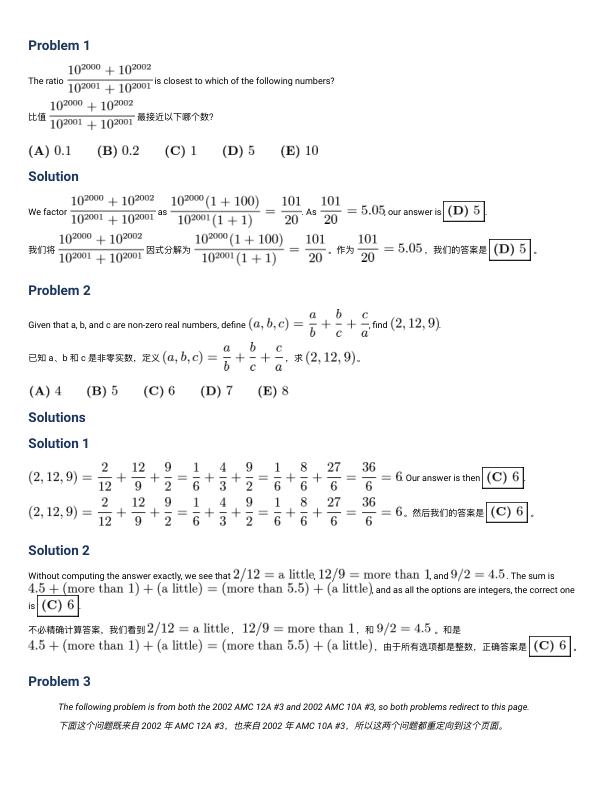2002 AMC amc10a 真题 答案 详解
| 序号 | 文件列表 | 说明 | ||
|---|---|---|---|---|
| 1 | 2002-amc10a-paper-eng.pdf | 4 页 | 175.47KB | 英文真题 |
| 2 | 2002-amc10a-key.pdf | 1 页 | 9.92KB | 真题答案 |
| 3 | 2002-amc10a-solution-eng.pdf | 18 页 | 990.43KB | 真题文字详解(英文) |
| 4 | 2002-amc10a-solution-eng-zh.pdf | 27 页 | 1.14MB | 真题文字详解(中英双语) |
英文真题
2002 AMC 10A Problems Problem 1 The ratio (\frac{10^{2000} + 10^{2002}}{10^{2001} + 10^{2001}}) is closest to which of the following numbers? (A) 0.1 (B) 0.2 (C) 1 (D) 5 (E) 10 Problem 2 For the nonzero numbers (a), (b), (c), define ((a, b, c) = \frac{a}{b} + \frac{b}{c} + \frac{c}{a}). Find ((2, 12, 9)). (A) 4 (B) 5 (C) 6 (D) 7 (E) 8 Problem 3 According to the standard convention for exponentiation, (2^{2^{2^2}} = 2^{(2^{(2^2)})} = 2^{16} = 65,536.) If the order in which the exponentiations are performed is changed, how many other values are possible? (A) 0 (B) 1 (C) 2 (D) 3 (E) 4 Problem 4 For how many positive integers (m) does there exist at least one positive integer (n) such that (mn \leq m + n) ? (A) 4 (B) 6 (C) 9 (D) 12 (E) infinitely many Problem 5 Each of the small circles in the figure has radius one. The innermost circle is tangent to the six circles that surround it, and each of those circles is tangent to the large circle and to its small-circle neighbors. Find the area of the shaded region. (A) π (B) 1.5π (C) 2π (D) 3π (E) 3.5π Problem 6 Cindy was asked by her teacher to subtract 3 from a certain number and then divide the result by 9. Instead, she subtracted 9 and then divided the result by 3, giving an answer of 43. What would her answer have been had she worked the problem correctly? (A) 15 (B) 34 (C) 43 (D) 51 (E)138 Problem 7 If an arc of (45^\circ) on circle A has the same length as an arc of (30^\circ) on circle B, then the ratio of the area of circle A to the area of circle B is (A) 4/9 (B) 2/3 (C) 5/6 (D) 3/2 (E) 9/4

真题文字详解(英文)
Problem 1 The ratio (\frac{10^{2000} + 10^{2002}}{10^{2001} + 10^{2001}}) is closest to which of the following numbers?
(A) (0.1) (B) (0.2) (C) (1) (D) (5) (E) (10)
Solution We factor (\frac{10^{2000} + 10^{2002}}{10^{2001} + 10^{2001}}) as (\frac{10^{2000}(1+100)}{10^{2001}(1+1)} = \frac{101}{20}). As (\frac{101}{20} = 5.05), our answer is (D) (5).
Problem 2 Given that a, b, and c are non-zero real numbers, define ((a, b, c) = \frac{a}{b} + \frac{b}{c} + \frac{c}{a}), find ((2, 12, 9)).
(A) (4) (B) (5) (C) (6) (D) (7) (E) (8)
Solutions Solution 1
((2, 12, 9) = \frac{2}{12} + \frac{12}{9} + \frac{9}{2} = \frac{1}{6} + \frac{4}{3} + \frac{9}{2} = \frac{1}{6} + \frac{8}{6} + \frac{27}{6} = \frac{36}{6} = 6). Our answer is then (C) (6).
Solution 2 Without computing the answer exactly, we see that (2/12 = a little, 12/9 = more than 1, and 9/2 = 4.5). The sum is (4.5 + (more than 1) + (a little) = (more than 5.5) + (a little)), and as all the options are integers, the correct one is (C) (6).
Problem 3 The following problem is from both the 2002 AMC 12A #3 and 2002 AMC 10A #3, so both problems redirect to this page. According to the standard convention for exponentiation, [2^{2^{2^2}} = 2^{(2^{(2^2)})} = 2^{16} = 65536.]
If the order in which the exponentiations are performed is changed, how many other values are possible? (A) (0) (B) (1) (C) (2) (D) (3) (E) (4)
Solution The best way to solve this problem is by simple brute force.
It is convenient to drop the usual way how exponentiation is denoted, and to write the formula as (2 \uparrow 2 \uparrow 2 \uparrow 2), where (\uparrow) denotes exponentiation. We are now examining all ways to add parentheses to this expression. There are 5 ways to do so:
- (2 \uparrow (2 \uparrow (2 \uparrow 2)))
- (2 \uparrow ((2 \uparrow 2) \uparrow 2))
- (((2 \uparrow 2) \uparrow 2) \uparrow 2)
- ((2 \uparrow (2 \uparrow 2)) \uparrow 2)
- ((2 \uparrow 2) \uparrow (2 \uparrow 2))

真题文字详解(中英双语)
Problem 1
The ratio (\frac{10^{2000} + 10^{2002}}{10^{2001} + 10^{2001}}) is closest to which of the following numbers?
(A) 0.1 (B) 0.2 (C) 1 (D) 5 (E) 10
Solution
We factor (\frac{10^{2000} + 10^{2002}}{10^{2001} + 10^{2001}}) as (\frac{10^{2000}(1+100)}{10^{2001}(1+1)} = \frac{101}{20}). As (\frac{101}{20} = 5.05), our answer is (D) 5.
我们将 (\frac{10^{2000} + 10^{2002}}{10^{2001} + 10^{2001}}) 因式分解为 (\frac{10^{2000}(1+100)}{10^{2001}(1+1)} = \frac{101}{20})。作为 (\frac{101}{20} = 5.05),我们的答案是 (D) 5。
Problem 2
Given that a, b, and c are non-zero real numbers, define ((a, b, c) = \frac{a}{b} + \frac{b}{c} + \frac{c}{a}), find ((2, 12, 9)).
已知 a、b 和 c 是非零实数,定义 ((a, b, c) = \frac{a}{b} + \frac{b}{c} + \frac{c}{a}),求 ((2, 12, 9))。
(A) 4 (B) 5 (C) 6 (D) 7 (E) 8
Solutions
Solution 1
((2, 12, 9) = \frac{2}{12} + \frac{12}{9} + \frac{9}{2} = \frac{1}{6} + \frac{4}{3} + \frac{9}{2} = \frac{1}{6} + \frac{8}{6} + \frac{27}{6} = \frac{36}{6} = 6). Our answer is then (C) 6.
(2, 12, 9) = (\frac{2}{12} + \frac{12}{9} + \frac{9}{2} = \frac{1}{6} + \frac{4}{3} + \frac{9}{2} = \frac{1}{6} + \frac{8}{6} + \frac{27}{6} = \frac{36}{6} = 6)。然后我们的答案是 (C) 6。
Solution 2
Without computing the answer exactly, we see that (2/12 = a little, 12/9 = more than 1, and 9/2 = 4.5). The sum is (4.5 + (more than 1) + (a little) = (more than 5.5) + (a little)), and as all the options are integers, the correct one is (C) 6.
不必精确计算答案,我们看到 (2/12 = a little, 12/9 = more than 1, and 9/2 = 4.5)。和是 (4.5 + (more than 1) + (a little) = (more than 5.5) + (a little)),由于所有选项都是整数,正确答案是 (C) 6。
Problem 3
The following problem is from both the 2002 AMC 12A #3 and 2002 AMC 10A #3, so both problems redirect to this page.
下面这个问题既来自2002年AMC 12A #3,也来自2002年AMC 10A #3,所以这两个问题都重定向到这个页面。

